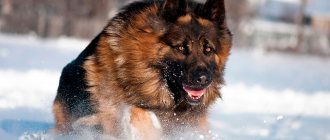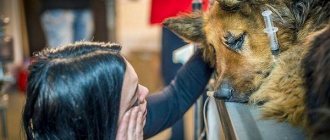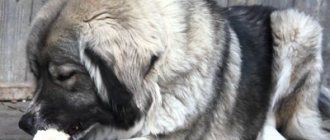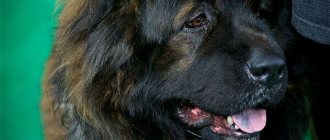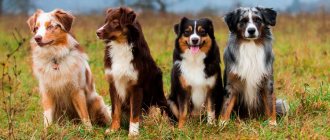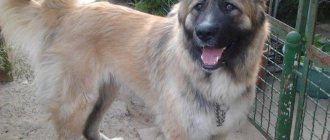Story
There is no reliable information about the origin of aboriginal Sheepdogs. Disputes about this are still ongoing, but researchers have identified 3 republics, the territory of which is considered to be the historical homeland of dogs: Dagestan, Georgia and Azerbaijan. Later, the range expanded to the Krasnodar Territory. There are 2 main theories about the origin. The first (also canonical) says that their distant relatives are the Tibetan Great Danes, which in ancient China were called the Tibetan pickling breed. The first mention of the Sheepdog's ancestors dates back to 1121 BC, when a puppy was presented to the Chinese Emperor as a gift.
According to the second version, the inhabitants of the country of Urartu, which was located on the Armenian Highlands (Southwest Asia), had dogs similar to Caucasian Shepherds. The state flourished in the 7th century BC, but Urartu ceased to exist a century later. Both theories indicate the ancient past of Caucasian Shepherd Dogs. They are believed to be over 3,000 years old.
Once in the Caucasus, the dogs underwent some changes. They were forced to independently adapt to the climate and harsh lifestyle, since the tribes did not engage in targeted breeding. Territorial isolation also played a certain role - dogs did not interbreed with other varieties of their own kind. Under the influence of many factors, shepherd dogs acquired thick fur and a fearless character. Nomadic life was complicated by constant attacks from wild predators, and the brave and strong Caucasian Shepherd Dogs resisted them.
Once upon a time they appeared on the slopes of Dagestan
Over time, representatives of this breed developed a simple philosophy: “friends are good, strangers are bad.” They became excellent guards and watchmen.
Historically, Sheepdogs spent most of their time in the company of only their owner, the shepherd (shepherd), from which they developed a strong attachment and devotion to one person.
In the 18th century, the breed began to be used at the front for the first time in history. Turkish troops willingly chose Caucasian Shepherds to guard the garrison against Russia. Later, Prince Vasily Mikhailovich Dolgorukov-Krymsky, who commanded the Russian army, wrote a decree on the use of representatives of this breed for the same purposes.
In the middle of the 18th century, when many states established transport links, the import of Caucasian Shepherd dogs to other countries began. It turned out that the external data and characteristic features of the breed were in great demand in many places.
In the 20s of the twentieth century, breeding work with this breed began for the first time on the territory of the USSR. And a decade later, Shepherd Dogs were shown at an exhibition in Germany (Nuremberg). This provided them with worldwide popularity.
The Second World War had a negative impact on breeding. In the post-war period, work with Sheepdogs was carried out very sluggishly. As a result, the height of the dogs has changed significantly: if previously their height reached even 80 cm, then subsequent generations became almost 15 cm lower.
In 1988, the First All-Union Exhibition of Service Dogs of Domestic Breeds took place in the USSR, at which Caucasian Shepherd Dogs were shown. And although all the prizes were given to their closest relatives, the Alabais, service dog handlers became interested in the breed, and soon took them into service.
Currently, the breed is recognized by the World Cynological Association (FCI) and is the national pride of not only Russia, but also the CIS countries. Caucasians are especially valued in Ukraine.
Where to buy and how to choose a puppy
If you want to purchase a purebred puppy and are not limited in funds, then, of course, it is better to start your search in nurseries and specialized clubs. Such establishments value their reputation and guarantee the purity of the breed and the physical and mental health of the pet. You can also visit exhibitions, where you will have the opportunity to communicate with several breeders at once and hear their advice on keeping the breed.
When choosing a nursery, make sure that the establishment is officially registered and ask for reviews about it. It would also be a good idea to familiarize yourself with the breed standard. But that's only half the battle. Next, you will have to communicate with the breeder. Professionals are usually happy to talk with potential buyers, give tours and provide truthful information about the puppies and their parents.
A Caucasian Shepherd dog at the age of 1 month must already be vaccinated, have a brand or microchip, as well as a package of documents including a medical passport, birth certificate, and certificates of conformity to the breed. If the breeder does not have the documents ready or he evades direct answers to your questions, then it is better to look for another place to buy a four-legged friend.
When the time comes to choose a puppy, take your time and carefully inspect the entire litter. After all, you have to choose not only the most beautiful, but also the healthiest puppy. To check your mental health, use a simple test. Drop some ringing object near him, for example, keys. If the puppy was not afraid, calmly approached and began to sniff the object, he is completely healthy.
Similar article: How to keep a Mongolian Shepherd Dog
In addition, the little “Caucasian” should be active, cheerful and playful, and rejoice at your arrival. His coat should be clean, teeth straight and white, mucous membranes (nose, eyelids, lips) black without any discharge. As for gender, you should know that a male dog is more effective as a guard. The female dog is more flexible, amenable to training and gets along with children.
Breed characteristics
The Caucasian Shepherd is a large dog with a powerful constitution and abundant hair. They have sexual dimorphism - females are noticeably smaller, with a narrower muzzle. Males may have a characteristic scruff on their neck. The World Canine Association classifies the breed as Group 2, Section 2.2 - Molosser/Mountain Dogs.
How many years do they live, weight, height, dimensions
The average life expectancy is 10-11 years, but this is only if they live on the street. If a dog spends more time in the house, and this happens, its lifespan is reduced. The desired height at the withers for males is 72-75 cm, but not less than 68 cm. Bitches are significantly smaller: 67-70 cm, but not less than 64 cm. However, a height above the specified values is not a serious defect.
The most reliable watchman Varvara
How much does it weigh
The average weight of females should not be less than 45 kg, for males the minimum value is 50 kg. Maximum weights greater than these values are welcome.
Head
The head is wide and large, looking like a blunt wedge. The transition from the forehead to the muzzle is present, but not very pronounced. The nose is only black. Other pigments such as brown or blue are not allowed. In individuals with a light color, seasonal changes in the color of the nose are possible.
Dogs have a large muzzle with strong jaws. The bite is correct (scissor). The absence of 1-2 molars or incisors is not penalized in show animals in the ring if they do not affect the bite in any way. The muzzle is level and parallel to the forehead, gradually tapering from base to tip.
What types of scissors are there for grooming dogs, do you need professional ones with a high price, and how to trim your pet at home
The eyes are slanted, medium in size, oval in shape. The iris of the eyes is only brown, for example, dark hazel. The shape of the eyes visually creates the image of a thoughtful and serious dog. The ears are medium, in the shape of a triangle. The base fits tightly to the skull. In their historical homeland they are docked short. However, ear cropping is not mandatory.
Neck and body
The neck is low, but wide and massive. The scruff is formed only in males with a long coat type. The body is well developed: it is wide, strong, harmonious. The format is slightly elongated, especially in females. The back is straight and strong. The withers are moderately expressed. The chest is deep, developed, strong. The front of the chest area protrudes slightly forward. The abdominal line is moderately developed.
Tail and limbs
The tail reaches the hock joint. A calm dog keeps it down. In other cases, the tail is crescent-shaped or in the form of a half ring. Cupping is not allowed.
The limbs are parallel and muscular. Set wide apart. The movements are leisurely and calm. Dogs are characterized by a powerful leap of the hind limbs. Representatives of this breed prefer to trot, sometimes breaking into a gallop.
Coat and colors
The coat is abundant, non-lying, at least 5 cm. It is smaller in some areas of the body - on the limbs (in front) and on the muzzle. The undercoat, like that of the Keeshond, is thick. The tail is heavily covered with long hair, due to which it looks even larger and more massive.
The standard specifies spotted (piebald) colors, but solid colors are also allowed. Solid black is excluded, despite the fact that the Caucasian Shepherd took part in the development of the Black Russian Terrier breed. Blue, fawn and chocolate colors are also not allowed. An optional element is the presence of a black mask on the head, which, however, is very common in the breed.
Among working dogs, color varies greatly. It can be fiery red, golden, brindle and even white.
Rage but controlled
Description of the breed
Caucasian Shepherds are self-confident, balanced and calm dogs. The description of the breed describes a strong, large body with well-developed muscles. The Caucasian Shepherd is perfectly adapted to the cold season and has unsurpassed guarding qualities.
- The weight of an adult dog ranges from 45-75 kg. Height at the withers is 62-70 cm. Males exceed females in weight and height.
- The head is heavy, massive, the skull is wide, the cheekbones are developed, the muzzle is voluminous, slightly shorter than the skull.
- bite , strong jaws, sharp fangs.
- The back is wide, strong, the top line is level, the stomach is tucked.
- The skin is thick and elastic. The standard provides for two varieties of Caucasian Shepherd: smooth-haired (coat length 6-7 cm) and long-haired (coat length 10-12 cm). In both cases the coat is thick and hard.
- The eyes are oval, widely spaced, dark in color.
- The ears are set high, triangular in shape, hanging.
- The tail is long and fluffy.
- The limbs are straight, strong and parallel, the paws are large and rounded.
Description of serious deficiencies
Serious defects are significant deviations from the specified external data standards. These include a lack of sexual dimorphism, an individual that is too light or coarse, a disproportionate head, or a too square body constitution.
Disadvantages also include sparse teeth, too large ears or an overly pointed muzzle. A hunched back, unbalanced movement or too sluggish drive from the hindquarters are also considered defects. Any behavioral deviations (anger, nervousness) are serious shortcomings. And in general, an angry Caucasian Shepherd is, as a rule, the result of improper upbringing of the owner.
If your pet has a pedigree and all the necessary documents, you can take part in special dog shows. To do this, check out the exhibition schedule for 2021.
Exhibitions with CAC rank awards for 2021.
Application
Most often, those who want a true friend and devoted protector want to buy a Caucasian Shepherd.
This is an ideal security guard for your own home, which is more convenient to live on the street.
Caucasian Shepherd Dogs that meet the standard often take part in exhibitions and are popular due to their size, long coat and interesting color variations.
A dog of this breed becomes very attached to its owner, and it is extremely difficult to tolerate even short-term separations.
At the same time, she needs an owner with a strong-willed character.
Female Caucasian Shepherd Dogs are more flexible and easier to train, males are more capricious, strong, impressive, they need a confident and experienced owner
Disqualifying faults
Disqualifying defects are those defects due to which the dog is not allowed into the ring. Vices can ruin a show career forever. The main disqualifying deficiencies include:
- docked tail;
- severe aggression or cowardice;
- bite problems;
- difficulties in assessing the movements of an individual;
- color of the iris that does not meet the standard;
- shades of the nose, eyelids and lips are not black;
- the presence of an unregistered color (black and tan, black and white, blue, liver, etc.);
- The height of a male or female is below the minimum specified by the standard.
What the varieties look like
Geographical isolation and nomadic lifestyle played a huge role in the formation of the Caucasian Shepherd Dog. Despite the uniform breed standard, there are many intrabreed subspecies of these dogs in the Caucasus. We will tell you what they are:
- Georgian - massive and larger individuals with an elongated body;
- Armenian - with a square body, light;
- Azerbaijani - are divided into 2 main subspecies: (mountain longhair and lowland / steppe shorthair);
- Dagestan - strong and rougher build;
- Chechen smooth-haired;
- Ingush (considered extinct);
- Ossetian (considered extinct);
- Kazbek - coarse constitution, spotted color;
- Garbana - distinguished by an aggressive character, a shorter muzzle (before snacking);
- Gergeti - powerful individuals with an elongated muzzle, many dogs have a white collar or blaze on the forehead and muzzle;
- Akhaltsikhe - the result of crossing the Kazbek, Garban and Gergeti types.
Azerbaijani type
In Azerbaijan, the breed is divided into several varieties. The basis is mountain and steppe (steppe), but there is an “intermediate” type. They have an average coat length (5-7 cm). The mountain aboriginal subspecies has an abundant coat of hair - 14 cm. The steppe people have short hair - 3-5 cm. It is the intermediate shepherd dogs that are considered the best representatives of their breed. They have all the necessary qualities to work with a flock.
Azerbaijani Caucasian steppe dogs are so unique that they are given their own name - Azerbaijani Aboriginal Dog. These are the same shepherd dogs, but with a short type of coat, which are not found anywhere else. The length of their fur does not exceed 5 cm.
Dogs of Armenia
Armenian Shepherds are very similar to the Georgian variety, however they are slightly smaller in size. These are long-haired individuals who most often have a monotonous brown or gray color. But at the same time, brindle and spotted colors are not uncommon.
Dagestan view
The Dagestan variety of Sheepdogs is distinguished by a coarser build and strong bones. These are square-type dogs with short or intermediate hair. Among the colors, brindle and spotted are the most common, but other “shirts” are also possible.
They are great friends
Character and temperament
Caucasian Shepherds are calm and balanced dogs. They are not characterized by aggression towards humans. They are very loyal to their owner and do not cope well with even the shortest separation from him.
The breed has a remarkably developed protective instinct. For thousands of years, dogs protected herds from wild predators and their owners' homes from strangers.
The breed has well-developed analytical thinking. Dogs know how to calculate their next actions. It is precisely these qualities that shepherds valued and continue to value, preferring to take private dogs from among Caucasian Shepherd Dogs.
Shepherds don't like fuss at all. They prefer a calm environment and do not strive to constantly waste their energy. Because of this economy of energy, dogs were unreasonably called lazy. The desire to preserve the reserve of strength is explained by the fact that the Caucasians accompanied the shepherd in a dangerous area where many wild wolves lived. Clashes with them were very frequent, so the dog had to be constantly ready to protect the owner and the flock.
Caucasian Shepherd Dogs are capable of full-time service from the age of 6 months. At this age they reach large sizes and can easily knock down an adult. Any strangers can enter the protected area if its owner is present next to the dog, who makes it clear that the stranger does not pose a danger. However, when alone, the Caucasian prefers to make his own decisions and considers any attempts by a stranger to penetrate his protected area as a threat.
Shepherds often use several Sheepdogs at once to protect themselves from packs of wild wolves. Because of this, dogs have a clear hierarchy. The owner should become an authority, but the pet should not be put under pressure. With proper training, Caucasian Shepherd Dogs will be endlessly loyal to their owner.
Representatives of this breed are tolerant of family members, including children. They are ready to protect them to the last, even other pets. However, you need to remember that the Caucasian Shepherd is not a toy and is dangerous for other people. It is important for the owner of such a pet to remember that the protective instinct is activated when any attempt by an outsider to enter the territory guarded by the Shepherd. And it doesn’t matter who is trying to get in - an adult, a child or another animal.
Training and education of the Caucasian Shepherd
Legends about the bloodthirstiness of the Caucasian wolfhounds give them the image of harsh animals. This result can be achieved by improper upbringing and training of a dog, therefore, when purchasing a fluffy puppy, the owner must be fully aware of the enormous responsibility that he has taken upon himself:
- The animal will grow rapidly. To train him competently, not a single day should be wasted.
- Caucasian wolfhounds have a peculiarity in their development. When they reach adulthood, they completely lose their childish charm and turn into impartial, self-confident, stubborn guards.
A puppy purchased from a kennel is given several days to adapt to the home and family. Then they systematically begin to educate, train and educate him. This is especially important for dogs living in cities. The dog must not:
- catch up with stray animals on walks;
- growl and bark at passers-by;
- be afraid of transport.
Considering the fact that the Caucasian Shepherd is a slowly maturing breed, they will be able to learn the first commands no earlier than 5-6 months:
- At the age of one, they must master all the basic commands: “No!”, “Ugh!”, “Sit!”, “Stand!”, “Lie down!”, “Near!”, “Teeth!”, “Muzzle!”, “Place!”, “Come to me!”
- The high intelligence of the Caucasian, his innate stubbornness becomes an obstacle to rapid learning.
- There is still no method for training Caucasian watchdogs.
- Even OKD (General training course) does not give quick and brilliant results.
For training, education and training, the owner must stock up on endurance and patience. A good emotional contact must be established between the owner and the animal:
- An intelligent dog with well-developed intuition picks up the owner’s mood by his voice and facial expressions.
- Therefore, the training course can last 2-3 years, since the dog does not like to do the same exercise several times.
- There is no need to believe the ridiculous talk about using physical force on the mountaineers to make them feel the master’s hand.
- This attitude will cause aggression and anger in the animal.
A stern, unyielding, strict demand for obedience is necessary, but this has nothing to do with corporal punishment. Bribery is also not appropriate. The shepherd does not need indulgences.
Caucasian Shepherds, like many large dogs, have a tendency to dominate (leadership over the owner). If measures to correct behavior are not taken in time, the dog will become uncontrollable. Signs of dominance in a Caucasian include disregard for the rules of etiquette:
- Begging for food.
- Allows himself to run into the house ahead of the owner.
- While walking on a leash, try to break free, run away, and drag the owner along with you.
- Growling, barking at family members.
Not all ZKS (Protective Guard Service) training methods are suitable for guard dogs:
- They need to be trained at home, since this is the object they are protecting, and not in a vacant lot, which is of no value to the dog.
- They will not pursue a fleeing person, and will remain to guard the house.
- Their skills cannot be honed on a sleeve full of cotton wool.
- They do not grab, but tear the clothes of real criminals who have encroached on the life or property of the owner.
They perfectly see the danger and in cases where it is created artificially, they do not react to it.
An owner who neglects to train and socialize the animal and maintain his own authority can get unpredictable results. The uncontrollability and ferocity of a Caucasian will become dangerous not only for those around him, but also for him. Ultimately, you will have to part with your pet.
Interesting photos and pictures
Caucasian Shepherd at a dog show
Beautiful Varvara. The house is under reliable security
And they say that they are evil... Don't believe it!!!
Tranquility and charm
Puppies are about two months old
Origin story
Even 2,000 years ago, the Caucasus became the homeland of this brave and hardy breed. Throughout the history of its development, the fearless shepherd has retained the best qualities inherent in herding dogs.
There are several theories about the origin of the Caucasian Shepherd. One of the most reliable versions says that the ancestors of the breed are Tibetan Great Danes.
In the XVIII-XIX centuries. These dogs were actively used for police service, as guard dogs. Already at the beginning of the 20th century. Caucasian Shepherd Dogs took part in the exhibition for the first time, after which in 1931. The first breed standards were determined. Well, the breed won world recognition in 1990.
Working qualities
In the Caucasus, shepherd dogs are still used for their intended purpose - they protect the herd and shepherd from wild wolves. However, representatives of this breed have been recruited for service for many years. Many service dog handlers choose the Caucasian Shepherd Dog as a watchman in the surrounding area.
Considering the external characteristics and character traits, it is not advisable to choose this breed as a companion. Caucasians have a complex character; in addition, almost every individual has a strong protective instinct.
Priotary individuals against the wolf
In the Caucasus, there is an ancient tradition that allows you to identify the best individual and test its working qualities. It consists of holding a special fight where dogs have the opportunity to demonstrate their strength and endurance. The fight made it possible to find the best defender, who then became a flock dog. The title of Champion went to those individuals who became winners throughout the season. After this, the Champion became a spiritual value.
Priotary dog
Working Shepherds are very hardy and unpretentious in food. Shepherds feed their charges corn and barley cakes, which are soaked in water left over from the production of goat cheese.
The best puppies up to 6 months are given goat's milk. Flock dogs obtain meat on their own: they hunt small animals, such as reptiles (snakes, lizards), and less often rodents (hares) and birds.
Flock Sheepdogs serve almost around the clock. They protect the herd from wild wolves, which are the main aggressors in the pastures. Several dogs will be able to give a worthy rebuff to a very strong enemy, even if the bear decides to attack an object guarded by Caucasians. The Bear does not consider the Sheepdog a threat; many shepherds say that in such fights several flock dogs can die at once. But even in such cases, the shepherds expect that they will rush at the angry bear without any doubt. Otherwise, they will prefer to get rid of cowardly individuals immediately.
Bite force of an adult Caucasian
In cynology there is such a thing as a grip. This is the use of teeth by a dog. It is measured in two quantities: jaw compression force and duration. By type, the grip is divided into 3 groups: strong, weak and dead. The Caucasian Shepherd is characterized by a strong grip - a strong instant bite followed by a tear.
The force of the bite can be measured in another quantity. Some sources indicate that the Caucasian bite is approximately 380-520 kg per m². Service dog handlers claim that the Shepherd's grip strength is 13.5 atmospheres. It's like being crushed by a tree 10 m high and about 22 cm in diameter.
People-oriented
Caucasian Shepherd Dogs can be divided into 3 groups: aboriginal, transitional and breeding. Aborigines are considered more resilient, strong and unpretentious. They have much better developed working skills, and the dogs themselves are less attached to humans. This feature is explained by the ability to make independent decisions.
Washing a dog's eyes at home and what products are needed for this
The transitional group is the middle between aboriginal and factory dogs. They have already been subjected to human selection and have characteristic features of both groups. The factory group represents Sheepdogs, which are the result of breeding work. They are more human-oriented and become more attached to their owner. They are easier to raise and maintain.
Advantages and disadvantages
The main advantage of the breed is its well-developed protective instinct. It has been developed over thousands of years and Caucasian Shepherd Dogs are still popular among shepherds and service dog handlers. Such a pet will protect not only its territory, but also its family members. The advantages also include:
- strong attachment to the owner;
- desire to save energy reserves;
- calmness and balance;
- excellent working qualities;
- ability for analytical thinking;
- ability to withstand heat and frost;
- unpretentiousness.
The complex and capricious character of the Caucasian is a significant drawback of the breed. This dog is completely unsuitable for beginners. In addition, a general training course is a mandatory element of education, even if the owner has some experience in keeping service breeds. Other disadvantages include:
- uncontrollability in the absence of training;
- impossibility of living in urban conditions (apartments);
- tendency to dominate.
Caucasian Shepherd character
If a Caucasian Shepherd puppy appears in the house, he can surprise the owner from the first minutes of his stay. These dogs have an overly independent and confident disposition. They are very smart and independent. It is quite difficult to train and completely subdue a dog. Only after thoroughly studying the character of his pet can the owner begin training.
The character is very persistent. Caucasian Shepherds are naturally endowed with courage and determination. They develop protective instincts and distrust of strangers at an early age. She has a very high intelligence and balance, trusting only members of her family, for whom she is ready to stand up if she senses the slightest danger.
When children live in the house, the dog independently defines itself as a patron, friend and protector. Despite his impressive size, he will take part in children's entertainment with pleasure and excitement. If a dog loves and trusts a certain person, then it will never offend him.
A very important character quality is confidence. Thanks to this feeling at the level of instinct, dogs react accurately and clearly in extreme situations. In times of danger, they make decisions instantly, while maintaining complete calm.
Care and maintenance
Caring for a Caucasian Shepherd is not as easy as it seems at first glance. Their thick coat needs daily attention; in other words, the pet needs to be brushed regularly with special brushes. The procedure is very important, since the coat is prone to frequent tangling and often falls into tangles. Read this article about a tangle cutter to help you choose the right tool to remove them. In some cases a haircut is required.
Nail trimming is not a common occurrence. It is enough to cut them once every 3-4 weeks. Ear cleaning takes place at approximately the same interval. Read more about caring for cropped ears here.
Bathing procedures should not be too frequent, as the hair can become very tangled after water. The recommended number of baths is once every month. When bathing, it is recommended to use a special shampoo for thick coats.
Caucasian Shepherds are not suitable for apartment living. They value space and the ability to move freely. The ideal option is a large aviary on the site. Keeping it on a chain is completely unsuitable. Although representatives of this breed tend to conserve energy, walks should last at least one hour.
Caucasian Shepherds have a very thick coat that protects them even in the most severe frosts. They are not afraid of winter down to -30º. Still, it is recommended to provide your pet with an insulated booth, covered with straw (it is necessary to avoid rotting litter). It will protect your pet in winter from strong and gusty winds. In cold weather, the dog's diet is improved.
The enclosure should be located so that in summer it is in the shade and in a windproof place. Depriving your pet's home of sunlight is completely undesirable. Dampness negatively affects a dog's health, increasing the risk of developing infectious diseases.
The soil or floor in the enclosure must be dry at any time of the year.
Feeding the Caucasian Shepherd is based on the general principles of feeding a dog and does not have any peculiarities of its own. The only serious recommendation is that you need to feed once a day, not more often. And of course, do not forget that puppies have their own feeding rules, which are more strict than those of adult dogs. Older dogs also have their own dietary rules.
If your dog is kept in a kennel, we recommend purchasing a large, automatic dog feeder. In this case, your pet will always receive the exact amount of food at a strictly defined time, which will have a beneficial effect on its digestion. In addition, we recommend adding an automatic drinker to ensure constant access to clean water that has gone through several stages of purification.
What to feed a puppy
In the first year of life, a “Caucasian” gains weight very rapidly. At the time of birth, the puppy’s weight is only 500–600 g, at 1 month its weight already reaches 3–4 kg, and after a year – 50–65 kg. In order for a growing body to develop properly, it needs a balanced diet.
Similar article: Description of the Hungarian guard shepherd Komondor
It is unacceptable to feed your puppy dry food. His menu should consist of natural products: lean meat (beef, horse meat, bones), fish, dairy products, as well as age-appropriate feed additives. At 2 months, the baby should be fed 5 times a day, offering at least 250 g of meat per day.
From the third month, the diet can be diversified with cereals (100 g/day), vegetables and fruits (30 g/day). By 6 months, the puppy is gradually transferred to three meals a day, and portions are doubled. From this age, his growth will not be as active, and by the age of 12 months he will completely switch to two meals a day.
Health
Caucasian Shepherd Dogs are distinguished by excellent health and it is not surprising: for hundreds of years the dogs led a nomadic life and adapted themselves to any weather conditions. However, the breed has a risk of diseases of viral origin. They develop if the enclosure is dirty. Therefore, it is very important to regularly clean the pet’s place of residence and clean the enclosure using disinfectants once every few months.
Large breeds have a tendency to dysplasia - destruction of the bone tissue of the hip joints. This disease occurs due to poor heredity, with an inactive lifestyle and in show animals. In severe form, the pet experiences severe pain when trying to move. In such cases, the dog loses the ability to move at all and dies from this.
It is better to take a puppy from a breeding kennel. Breeders must be required to provide all documents about their parent dogs.
They are not even a month old
Mating, pregnancy
Caucasian Shepherds are late maturing dogs. Despite the fact that puberty in both sexes begins after 6 months and up to a year, it is better not to breed at this time.
Until the age of 2 years, the formation of the reproductive system in females and males occurs, and mating before this age can cause various diseases of the genital organs.
Mating takes place in the male dog's territory. Previously, dog owners must take all necessary preventive measures: give the pet an anthelmintic, undergo routine vaccination, etc. The owner of the bitch must correctly determine the phase of estrus (estrus), i.e. when the female is at the peak of sexual heat. It is not difficult to determine the phase: the bitch shows interest in male dogs, flirts with them, and when you press on the croup, moves her tail to the side. But each organism is individual, so if any questions arise, you can and should consult a veterinarian.
It is possible to breed a male throughout his entire life. With the female the situation is different - mating takes place from 2 to 8 years. For the offspring to be healthy, both partners must not have any diseases. For the first mating of an inexperienced male, it is better to choose a calm, older female. For the first mating of a female, it is recommended to find an experienced dominant male.
Pregnancy in dogs is the same for all breeds and lasts on average 57-72 days. The first day of pregnancy is traditionally counted from the day of the last mating. A mated female in most cases becomes calmer, but some females may continue to lead an active lifestyle. Until 5 weeks, all working and service females are used for their intended purpose. If pregnancy is confirmed, she is transferred to a more relaxed regime and conditions of detention are improved.
The second half of pregnancy is considered a vulnerable period. The bitch is given increased attention. She should not compete or get into fights with other dogs. Her diet is improved and the necessary vitamins are added for the development of her offspring. Service dogs are exempt from work, but are not deprived of physical activity.
At the 5th week after mating, it is advisable to perform an ultrasound on the dog to confirm or refute the situation. Otherwise, the bitch may develop a false pregnancy.
Childbirth
Childbirth takes place differently depending on the type of dog - native or factory. Aborigines are accustomed to taking care of themselves, so the owner will only need to provide a safe space for the expectant mother and puppies. For females, a “kindergarten” is arranged - a maternity box or a small room (aviary), where the temperature should be more than +5º. In most cases, aboriginal dogs refuse human help and do not allow anyone to approach them.
Factory dogs, being more human-oriented, need the help of the owner, including during the birth of offspring. The owner must provide a sterile place for birth (playpen) and monitor the pet, as problems can arise at any time. If the bitch herself makes a nest for herself in some room, then after the appearance of small puppies she may not let anyone in there.
If the offspring are numerous, then the mother’s dog may not have enough colostrum for all of them. In this case, it is recommended to supplement the puppies with a special dog milk substitute.
Search and price of a puppy in Russia
Now a few words about how much a puppy costs. The Caucasian Shepherd is a popular breed in Russia and the CIS countries. Finding a nursery is not difficult. There are more than 10 of them in the Moscow region alone. Minimum prices for puppies start from 5-10 thousand rubles and can reach up to 70 thousand for a purebred show-class pet.
We recommend contacting nurseries, as unscrupulous amateur breeders can sell mestizos under the guise of purebred individuals. Fraudsters take advantage of gullible customers and offer completely different dogs under the guise of a Caucasian Shepherd.
If there is a need for a working dog that will be assigned to the flock, it is better to contact the shepherds and shepherds of the Caucasus. At the same time, they are engaged in breeding the breed and their main guideline is their abilities and skills. However, they do not rely on the FCI standard, so the puppies may not match the exterior, but have ideal skills for flock work. The cost of such dogs has very wide ranges.
Interesting Facts
- The world's largest Caucasian Shepherd lives in Ukraine, in the city of Odessa. The pet's name is Grizzly, he weighs more than 100 kg;
- In 1933 I.V. Stalin signed a decree “On the development of domestic dog breeding”, as a result of which most of the Shepherd dog population was taken out of the Caucasus. In 1941, dogs were evacuated en masse after the start of the Great Patriotic War;
- Caucasian Shepherd Dogs were used to breed the Moscow Watchdog - mainly individuals taken from Azerbaijan were used;
- In the 30s of the twentieth century, a male named Topush, who killed more than a hundred wolves in his life, was recognized as the best working Shepherd Dog.
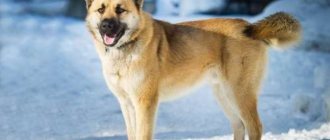
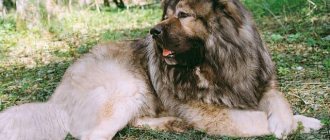
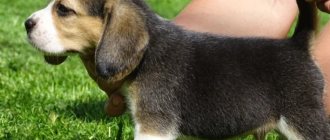
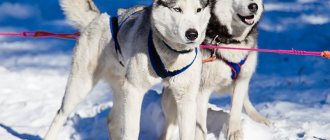
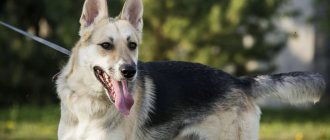
![Weight of a Caucasian Shepherd puppy by month [table]? How to feed](https://loshadka24.ru/wp-content/uploads/ves-shchenka-kavkazskoj-ovcharki-po-mesyacam-tablica-kak-kormit-330x140.jpg)
